2025/03/21Number of reading(14121)Number of comments(0)
一、Target Audience
Business Owners, Operators
二、Feature Introduction
In Amazon retail, products are the foundation. All our operational activities revolve around products. Therefore, a comprehensive understanding of overall product sales is crucial.
However, Amazon Seller Central data is scattered and complex. Operators need to download various data reports from Seller Central and then manually compile them. This increases daily workload, and data updates are delayed. Moreover, data can only be viewed for single stores and single marketplaces, making it impossible to directly aggregate and analyze the performance of the same product across different marketplaces/stores.
SellerSpace's Product Analysis feature starts from the product dimension, aggregating all operational data for products, refining analysis dimensions to meet almost all product analysis needs. It also supports viewing aggregated data across multiple marketplaces, helping sellers deeply analyze product sales performance, quickly identify products with data anomalies, and promptly make operational strategy adjustments.
三、Usage Scenarios
- Analyze product sales performance across all time periods and marketplaces from a product-centric perspective.
- Compare and analyze product sales data for different brands.
- View and analyze product sales details by aggregate, daily, weekly, or monthly data.
- Analyze sales data for different categories of products by adding tags to products.
- Analyze product data by Parent, Child, or SKU dimensions, covering all product analysis levels.
- In-depth analysis of all data for a single product: various metrics and period-over-period comparisons, expense details, advertising performance, inventory, hijacking, etc.
四、Data Synchronization Frequency
Synchronized every 15-30 minutes
五、Operation Guide
1. Operational Metrics
Product Analysis includes 33 metrics in total. You can view and analyze product data from different dimensions:
Ranking Data: Subcategory Rank, Main Category Rank
Sales Data: Units Sold, Sales Revenue, Order Quantity
Advertising Data: Ad Orders, Order Share (Ads), Advertising Spend, Spend Share (Ads), Ad Sales, Sales Share (Ads), ACOS, Ad Impressions, Ad Clicks, Ad CTR, CPC, CVR
Profit Data: Total Expenses, Returns, Return Rate, Gross Profit, Gross Profit Margin, ROI
Performance Data: Sessions, Mobile App Sessions, Browser Sessions, Conversion Rate, Page Views, Mobile App Page Views, Browser Page Views, Buy Box Win Rate, Organic Clicks, Organic Conversion Rate
Tip: Product Analysis only displays sales data for products with orders or advertising spend. If a product has no operational performance, it will not be displayed.
 +
+
We can sort all metrics according to our viewing habits.
Click [Customize Columns] to enter the sorting settings.
 +
+
On the "Customize Columns" settings page,
we can choose to display only certain metrics and drag metrics to sort them.
 +
+
2. Data Download
Most of the analysis results in Product Analysis support exporting. After we complete the analysis, click the [Export] button in the upper right corner to export the current analysis results with one click.
 +
+
Next, we will explain in detail how to use the [Product Analysis] feature to analyze product performance.
3. Data Analysis
The Product Analysis feature provides multiple analysis dimensions, including: Marketplace Dimension, Time Dimension, Fulfillment Method, Brand, Tags, Parent-Child ASIN, etc. These dimensions can be freely combined to help us comprehensively understand product performance and provide data support for operational decision adjustments.
You can select product data for different dimensions through the filter bar.
 +
+
3.1 Data Analysis: Multi-Marketplace Products
If our products are sold in multiple marketplaces, we can directly view the sales performance of these products in Product Analysis.
Click the marketplace selection button in the upper left corner and select the marketplaces you want to view.
 +
+
After selecting the marketplaces, we can filter sales data for the same product across different marketplaces according to our classification habits, such as tag classification, SKU naming, etc.
 +
+
3.2 Data Analysis: Time Dimension
We can view product sales data for all time periods and support aggregating data by aggregate, daily, weekly, and monthly dimensions to help us compile sales statistics and create reports.
Click the time selection button, select the time period you want to view, and then select different data aggregation dimensions according to the selected time period.
 +
+
View by Aggregate: Primarily view the total sales data of all products.
 +
+
View by Day: Supports viewing daily sales data for the selected time period, helping to analyze daily product performance and trends.
 +
+
View by Week: Supports viewing data for each natural week in the selected time period, helping us analyze weekly product performance from a weekly perspective.
 +
+
View by Month: Supports viewing data for each natural month, helping us compare and analyze data for different months.
 +
+
When we choose to view by day, week, or month, we can also choose [Metrics as Columns] or [Dates as Columns] to help us view and analyze data more conveniently.
Metrics as Columns:
 +
+
Dates as Columns:
 +
+
3.3 Data Analysis: Fulfillment Method
Amazon products generally have 2 fulfillment methods: FBA + FBM. We can analyze product performance based on different fulfillment methods.
Click [Fulfillment Method] and select the method you want to analyze.
 +
+
3.4 Data Analysis: Brand Dimension
A store can register multiple brands, and sales may vary between brands. We can analyze product performance from a brand perspective.
Click the [Brand] button and select the brand you want to analyze.
 +
+
3.5 Data Analysis: Different Tag Classifications
In addition to some system-preset filtering conditions, we can also set different tags for products according to our actual situation for classification management. When analyzing their sales performance, we can analyze them by tag classification.
In addition to product tags, ERP tags, which are local product tags, are also supported for filtering. Since the products we purchase may be sold in more than one marketplace, if this is the case, we can filter ERP tags to directly view the aggregated sales performance of this product across all marketplaces.
All tags can be multi-selected.
Next, let's first see how to use product tags to filter and analyze.
Take filtering products with the tag: 123 as an example.
First, set tags for the products.
Enter the [Product Cost] feature and find the product you want to set the tag: 123.
 +
+
Select all products, click [Batch Set Tags], and set the product tag to: 123.
 +
+
Then, filter tag: 123, and you can directly view and analyze the operational data of products under this tag.
 +
+
At the same time, we can also flexibly apply the [Exclude Tags] tool.
A product can be set with multiple tags. If we only want to analyze certain products under a certain tag classification, we can use the [Exclude Tags] condition to exclude products under that tag that we do not want to view.
 +
+
Next, let's take a look at how to filter with ERP tags.
The use of ERP tag filtering is similar to product tags. You also need to set tags for local products first, and then filter and analyze.
Local product tag setting path: ERP -> Local Products -> Tag Settings (setting method is the same as product tags)
 +
+
After setting, you can filter [ERP Tags] to view all sales performance of this local product.
 +
+
3.6 Data Analysis: Different Attribution Levels
Amazon products are divided into standard and non-standard products. Therefore, there will be sales situations for single products or multi-variation products. For the sales of these products, we also support viewing the corresponding product sales performance by child or parent ASIN according to different product dimensions.
At the same time, one ASIN can generate multiple SKUs for sale, such as hijacking operations. For this situation, we also support viewing and analyzing by SKU dimension, with data refined to the smallest dimension.
 +
+
3.7 Product Analysis: In-depth Analysis of a Single Product
In addition to overall product analysis, we can also further analyze the performance of a single product, including: historical performance of various metrics, 24-hour order distribution, expense details, period-over-period comparison of metrics, and advertising performance, etc., helping us deeply understand the performance of the product, promptly identify anomalies, and fill gaps.
Click the analysis button next to a single product to enter the analysis data list.
 +
+
First, it should be noted that the data dimension of product analysis is based on the attribution level dimension we initially selected.
For example, if we initially selected the child ASIN dimension, then the data dimension in product analysis is the child ASIN dimension, and so on.
The viewing dimension initially selected: Child ASIN dimension
 +
+
Product analysis dimension: Child ASIN dimension
 +
+
Entering the product analysis page,
we can see that there are 6 data lists: Historical Performance of Various Metrics, 24-Hour Order Distribution, Expense Details, Performance of Each SKU, Period-over-Period Comparison of Metrics, and Advertising Performance.
Next, we will introduce the usage methods one by one. (The usage method is basically the same as the product analysis of [Homepage Dashboard])
① Historical Performance of Various Metrics
The detailed analysis of a single product includes 54 metrics that can be analyzed, helping us deeply analyze the performance of each metric, find anomalies from the historical performance of metrics, or help us track whether the effect of optimization operations meets the standard, so that we can optimize promotion methods in time according to business goals.
The operation method of historical performance data of metrics is as follows:
Taking analyzing the advertising ACOS performance of the selected child ASIN product last week in table form as an example,
First, set the data time.
Click Time and select the data time as [Last Week].
 +
+
Supplementary explanation:
The time dimension of product analysis supports three dimensions: day, week, and month. You can select the corresponding data time range according to your actual analysis situation.
 +
+
Then, select the data presentation form.
There are 2 presentation forms for metrics: Graph + Table. According to the presentation form of the data, we can set the metric display order or quantity respectively.
Click the icon in the upper right corner to switch the presentation form with one click.
The current presentation form is table, so no switching is needed.
 +
+
Finally, we can choose to set the metric display order.
When you select the [Table] form, we can customize the display order of metrics.
We want to analyze the [ACOS] metric, but it cannot be analyzed alone and needs to be analyzed together with other advertising metrics. Therefore, we can choose to put the required advertising metrics together for easy viewing.
Click [Set Metric Display Order] in the upper right corner to enter the settings.
 +
+
Customize the metric display order, drag and sort, and put advertising-related metrics together for easy analysis.
 +
+
Special Note: The above operation order is not fixed. Operate according to your own needs.
At this time, we can analyze the advertising ACOS for last week.
 +
+
For example:
It can be seen from the data in the figure that the overall ACOS of this marketplace last week was relatively high.
At this time, we need to analyze the reasons for the high ACOS: Is it caused by launching new products leading to high ACOS? Because the advertising goal of new products is to obtain high exposure and high traffic, but the conversion rate is low, is this the reason for pulling up the overall ACOS? Or is it because the keywords are not accurate, resulting in some irrelevant matching keywords that consume a lot of budget and have no conversion, leading to high ACOS? ... We can analyze specifically according to the actual situation.
In addition to the above [Table] data presentation form, we can also choose the [Graph] form to analyze the historical performance of metrics.
Graphs can more intuitively view the historical performance trend of metrics, whether it is an upward or downward trend, or other performance, etc.
The following explains the operation method of the graph:
Click the switch button in the upper right corner to switch to the graph with one click.
 +
+
We can set the default display metrics and metric display order for [Graph].
Click the [Set Default Display Metrics] button to enter the settings.
 +
+
Set default display metrics:
 +
+
Graph operation tips tutorial:
Hover the mouse over the curve to view detailed data of the corresponding node;
 +
+
Hover the mouse over a single curve to view which metric the curve corresponds to and the detailed data of the corresponding node;
 +
+
Click the curve to only view the metric corresponding to the curve. Move the curve out and click again in the blank space to restore to displaying all the default metrics you set;
 +
+
Click or hover the mouse over the metric below the [Set Default Display Metrics] button to hide or display the metric;
 +
+
In addition to the curve trend graph, bar graphs are also supported for viewing, and the operation method is consistent with the curve trend graph.
Click the graph button on the right to switch with one click.
 +
+
Data Export
After we complete the analysis, we can export the currently analyzed data results. The export format is Excel spreadsheet, which is convenient for us to re-organize and analyze.
Click the [Export] button to export with one click.
 +
+
Next, we will explain in detail how to use the [Product Analysis] feature to analyze product performance.
3. Data Analysis
The Product Analysis feature provides multiple analysis dimensions, including: Marketplace Dimension, Time Dimension, Fulfillment Method, Brand, Tags, Parent-Child ASIN, etc. These dimensions can be freely combined to help us comprehensively understand product performance and provide data support for operational decision adjustments.
You can select product data for different dimensions through the filter bar.
 +
+
3.1 Data Analysis: Multi-Marketplace Products
If our products are sold in multiple marketplaces, we can directly view the sales performance of these products in Product Analysis.
Click the marketplace selection button in the upper left corner and select the marketplaces you want to view.
 +
+
3.2 Data Analysis: Time Dimension
We can view product sales data for all time periods and support aggregating data by aggregate, daily, weekly, and monthly dimensions to help us compile sales statistics and create reports.
Click the time selection button, select the time period you want to view, and then select different data aggregation dimensions according to the selected time period.
 +
+
3.3 Data Analysis: Fulfillment Method
Amazon products generally have 2 fulfillment methods: FBA + FBM. We can analyze product performance based on different fulfillment methods.
Click [Fulfillment Method] and select the method you want to analyze.
 +
+
3.4 Data Analysis: Brand Dimension
A store can register multiple brands, and sales may vary between brands. We can analyze product performance from a brand perspective.
Click the [Brand] button and select the brand you want to analyze.
 +
+
3.5 Data Analysis: Different Tag Classifications
In addition to some system-preset filtering conditions, we can also set different tags for products according to our actual situation for classification management. When analyzing their sales performance, we can analyze them by tag classification.
In addition to product tags, ERP tags, which are local product tags, are also supported for filtering. Since the products we purchase may be sold in more than one marketplace, if this is the case, we can filter ERP tags to directly view the aggregated sales performance of this product across all marketplaces.
All tags can be multi-selected.
Next, let's first see how to use product tags to filter and analyze.
Take filtering products with the tag: 123 as an example.
First, set tags for the products.
Enter the [Product Cost] feature and find the product you want to set the tag: 123.
 +
+
Select all products, click [Batch Set Tags], and set the product tag to: 123.
 +
+
Then, filter tag: 123, and you can directly view and analyze the operational data of products under this tag.
 +
+
3.6 Data Analysis: Different Attribution Levels
Amazon products are divided into standard and non-standard products. Therefore, there will be sales situations for single products or multi-variation products. For the sales of these products, we also support viewing the corresponding product sales performance by child or parent ASIN according to different product dimensions.
At the same time, one ASIN can generate multiple SKUs for sale, such as hijacking operations. For this situation, we also support viewing and analyzing by SKU dimension, with data refined to the smallest dimension.
 +
+
3.7 Product Analysis: Single Product Detailed Analysis
In addition to overall product analysis, we can also further analyze the performance of a single product, including: historical performance of various metrics, 24-hour order distribution, expense details, period-over-period comparison of metrics, and advertising performance, etc., helping us deeply understand the performance of the product, promptly identify anomalies, and fill gaps.
Click the analysis button next to a single product to enter the analysis data list.
 +
+
② 24-Hour Order Distribution
The [24-Hour Order Distribution] data of a single product mainly views the 24-hour distribution of order quantity, units sold, and sales revenue of the selected product. In addition to helping us view data, it can also help us find out the peak ordering period of the product, thereby helping us better plan promotions.
It is similar to [Hourly Sales Data for the Last Four Weeks], but also slightly different. The specific differences are as follows:
Hourly Sales Data for the Last Four Weeks: Can only view data for the last 28 days, but supports viewing the 24-hour order distribution of different products, marketplaces, advertising, and tagged products;
24-Hour Order Distribution: Supports viewing data for all time periods, but only supports viewing the 24-hour order distribution of the selected product.
Its usage method is basically the same as the [24-Hour Order Distribution] tool in Marketplace Analysis.
 +
+
The data operation method of 24-hour order distribution is as follows:
Taking viewing the 24-hour order distribution of the selected product for last month in graph form to find out the peak ordering period as an example.
Same as the operation of [Historical Performance of Various Metrics], we can customize the data time range.
Click the time icon in the upper left corner to set the time range and select [Last Month].
 +
+
Then select the presentation form: Graph.
24-hour order distribution also has two presentation forms: graph and table.
The current form is graph, so there is no need to switch.
 +
+
The 24-hour order distribution graph defaults to displaying the 24-hour distribution of 3 metrics: order quantity, units sold, and sales revenue.
Click the metric title to switch to view the hourly distribution of the corresponding metric.
The system defaults to viewing order quantity data, so we don't need to switch.
 +
+
Through the above operations, the 24-hour order distribution data for last month is obtained.
Next is the explanation of analysis operations.
24-hour order distribution will also synchronously display period-over-period data comparison to facilitate analysis of data changes.
For example: if we choose to view today, the period-over-period data will be the same period yesterday. If you choose the last 7 days, the period-over-period will be the previous 7 days. If it is last month, the period-over-period will be the month before last month, and so on.
 +
+
Click the period-over-period metric icon to choose to view or hide the trend data of the metric separately.
 +
+
Hover the mouse over the period-over-period metric or the corresponding data in the graph to view the trend of the data separately.
 +
+
Hover the mouse over the graph in the chart to also view the details of the data separately.
 +
+
When we choose the [Graph] presentation form,
in addition to bar graphs, you can also switch to curve graphs, stacked bar charts, or copyable table graphs to adapt to the analysis habits of different seller friends.
Click the icon on the right to switch with one click.
Note: The operation methods of each chart in [Graph] are basically the same as the graph operation tips of [Historical Performance of Various Metrics], and will not be repeated here.
 +
+
Curve graph:
 +
+
Bar graph:
 +
+
Stacked bar chart:
 +
+
Copyable table:
 +
+
When the presentation form is graph, the graph supports exporting, exporting to image format, which is convenient for us to make reports.
Click the export button to export with one click.
 +
+
When we choose the [Table] presentation form,
it will display the 24-hour data of order quantity, units sold, sales revenue, and their period-over-period comparison data.
Note: Table data here does not support exporting!
 +
+
Back to our initial need, which is to find out the peak ordering period based on last month's order data.
Therefore, we can choose a stacked bar chart, which can more clearly identify the ordering time period.
 +
+
From the chart data, it can be seen that the peak ordering period is from 7:00 to 21:00.
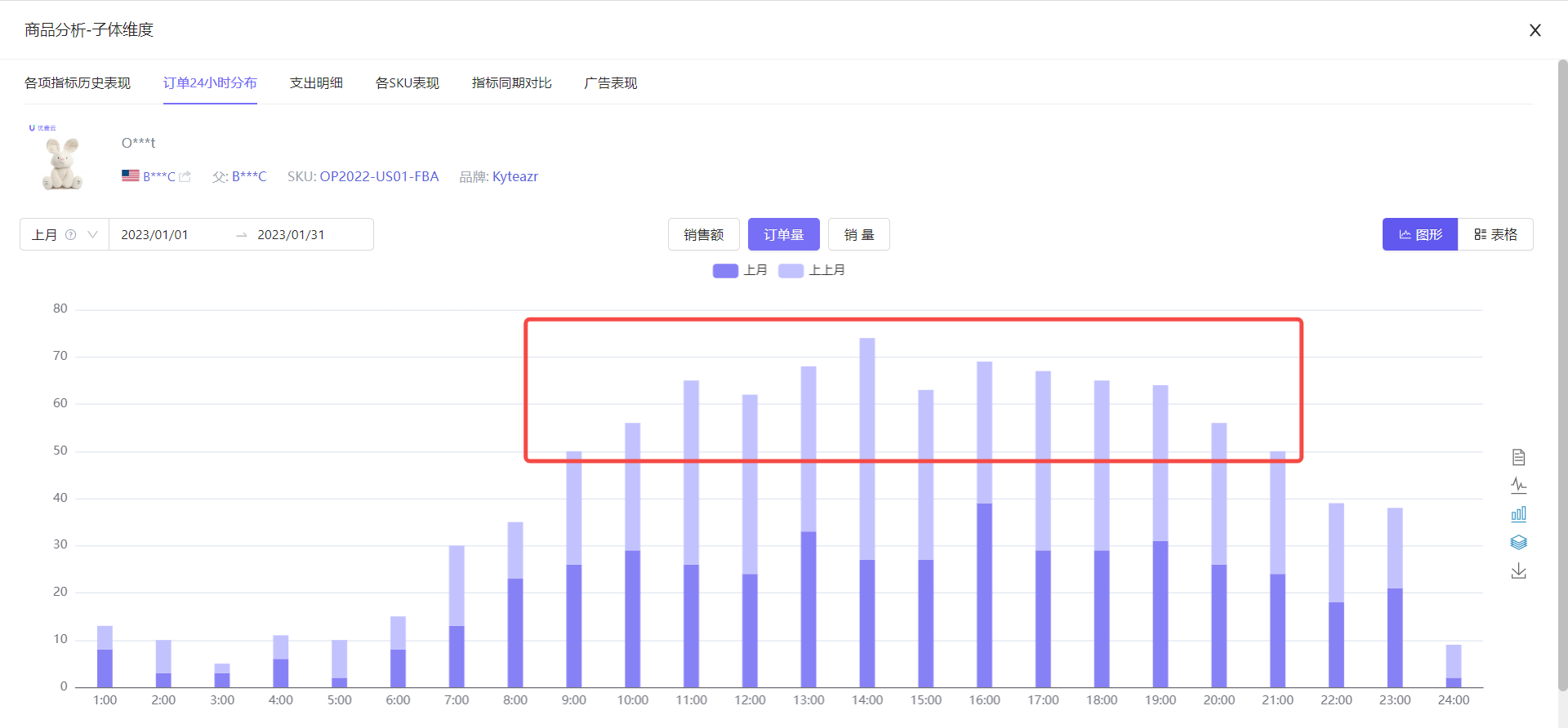 +
+
③ Order Area Distribution (New Online)
Order area distribution shows the distribution of ordering areas for the current product, as well as the area distribution data of refund and replacement orders.
Through order area distribution data, we can find out high-ordering areas, and combine with [Keyword Ranking] and [Keyword Positioning] functions to target keywords and position ads to obtain more accurate orders.
At the same time, we can also efficiently analyze return and exchange areas and reasons, helping us obtain first-hand buyer feedback, thereby optimizing products and improving profit margins.
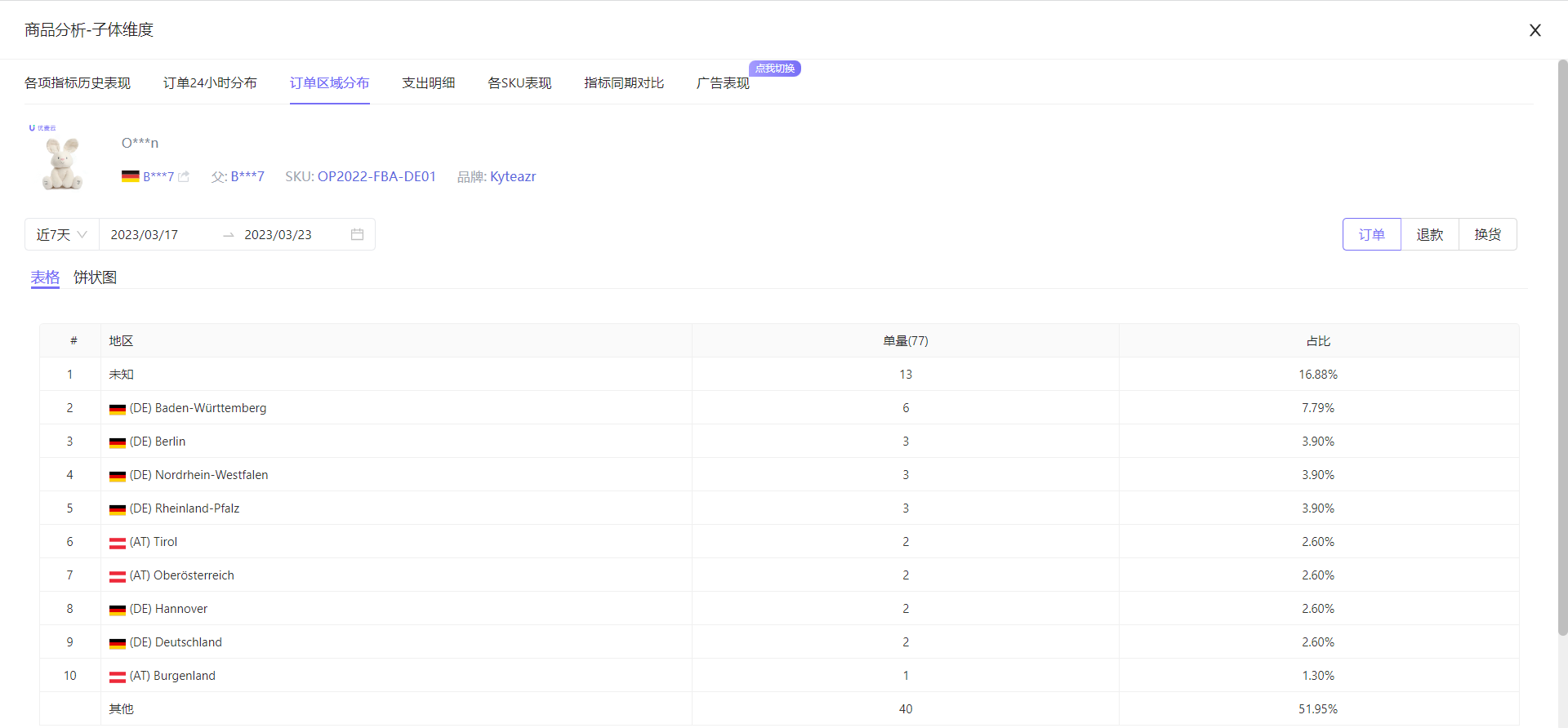 +
+
Taking analyzing the order and return/exchange area distribution of the selected product for last month as an example.
First, select the data time: Last Month.
We can customize the data time range. However, it is recommended to choose a longer time span for analysis.
Due to some pending orders, Amazon may return 0 data within a certain period, including order address data. At this time, the number of orders with unknown order areas is large, which is not conducive to analysis.
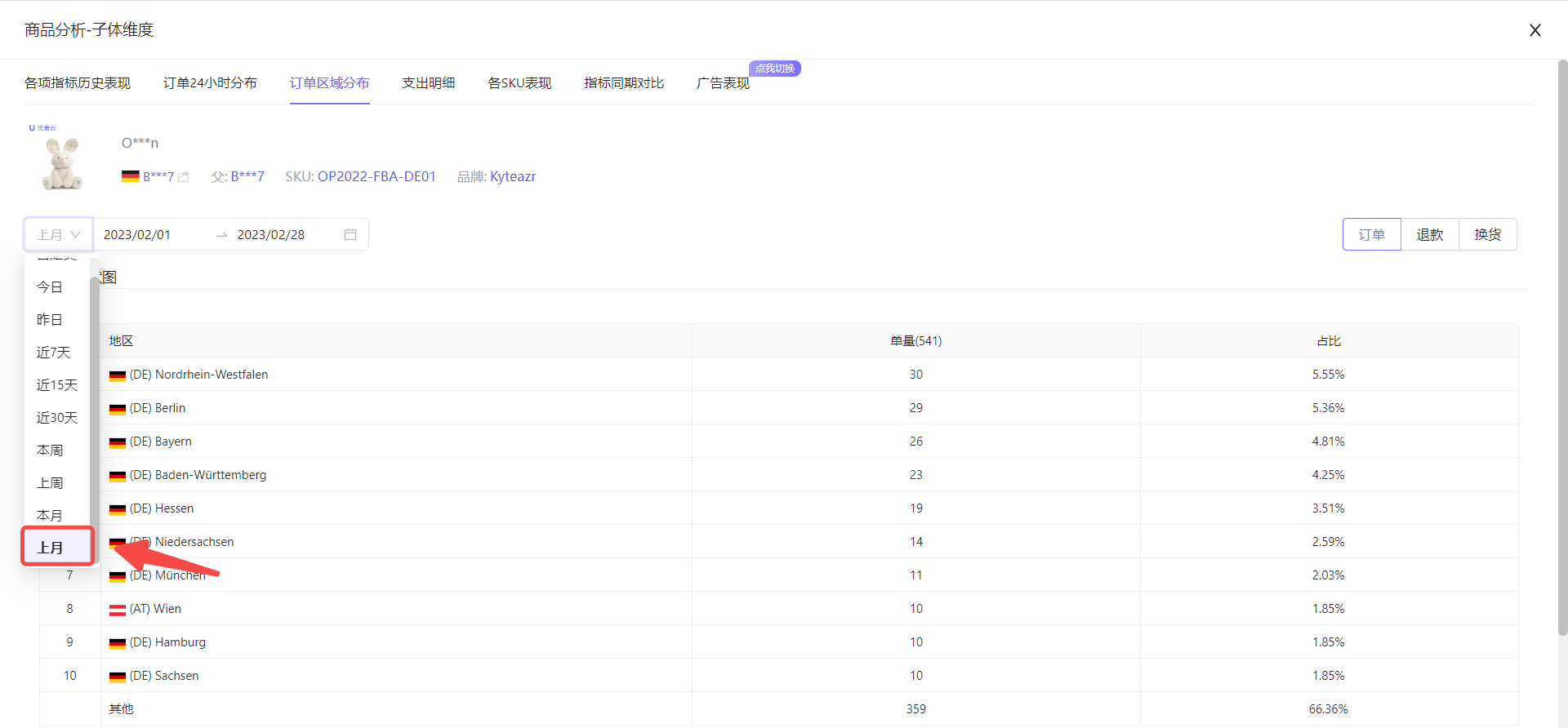 +
+
After selection, the system will automatically display the top ten ordering areas in terms of order quantity in the orders of last month in table form.
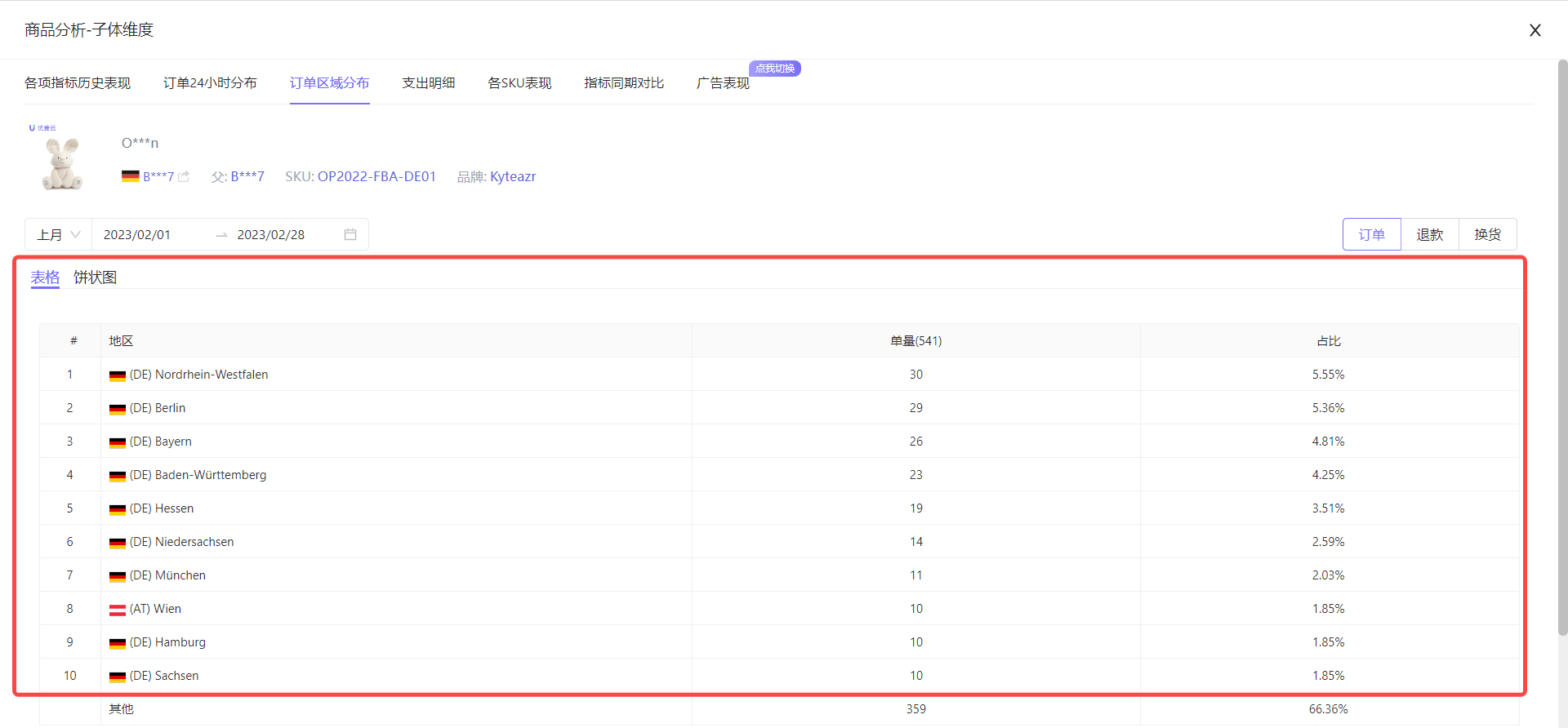 +
+
Among them, in addition to clear areas, it may also include two data of Unknown and Other:
- Unknown: Orders that did not get the address, such as pending orders
- Other: Addresses with order quantity outside the top ten are collectively classified as "Other"
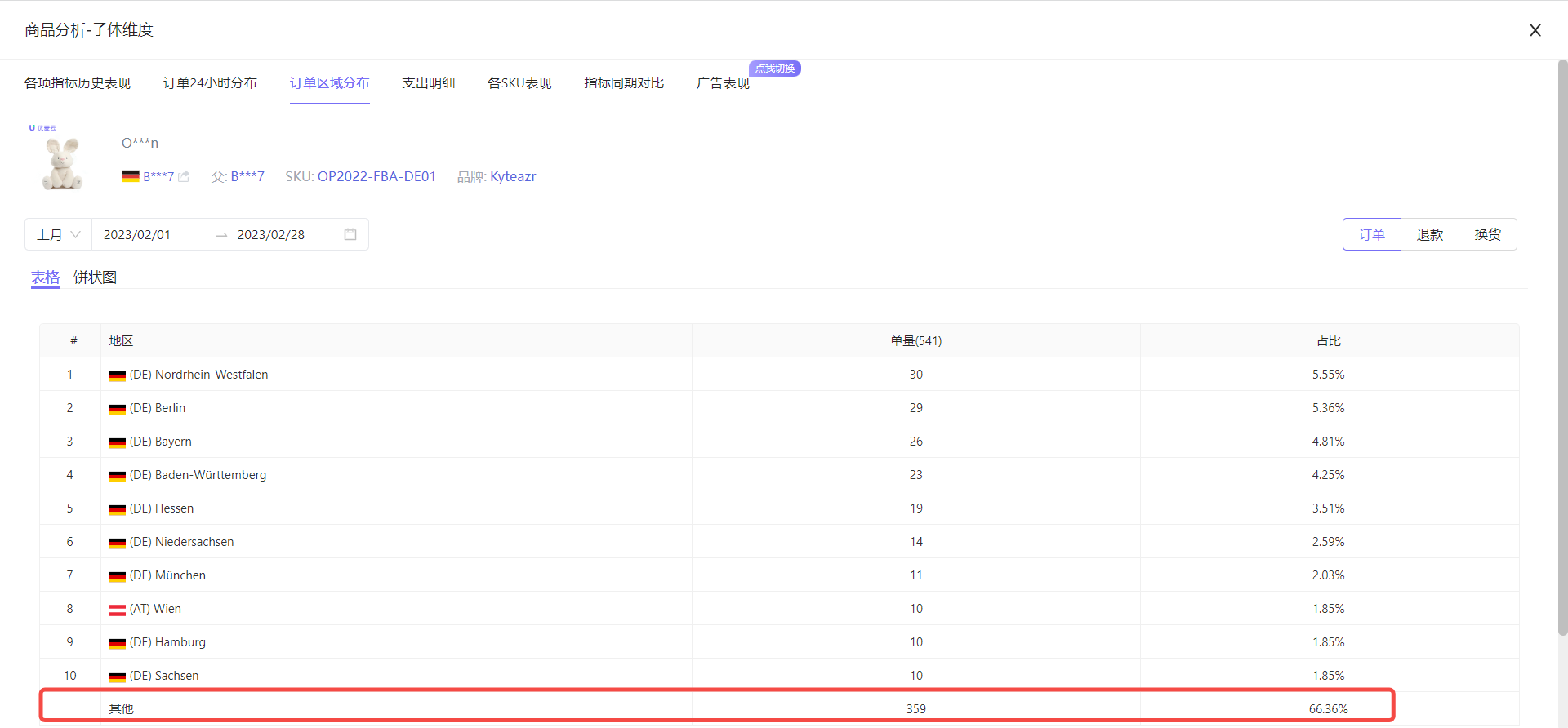 +
+
In addition to table form, we can also view the top ten area information in pie chart form.
Click the [Pie Chart] button to switch with one click.
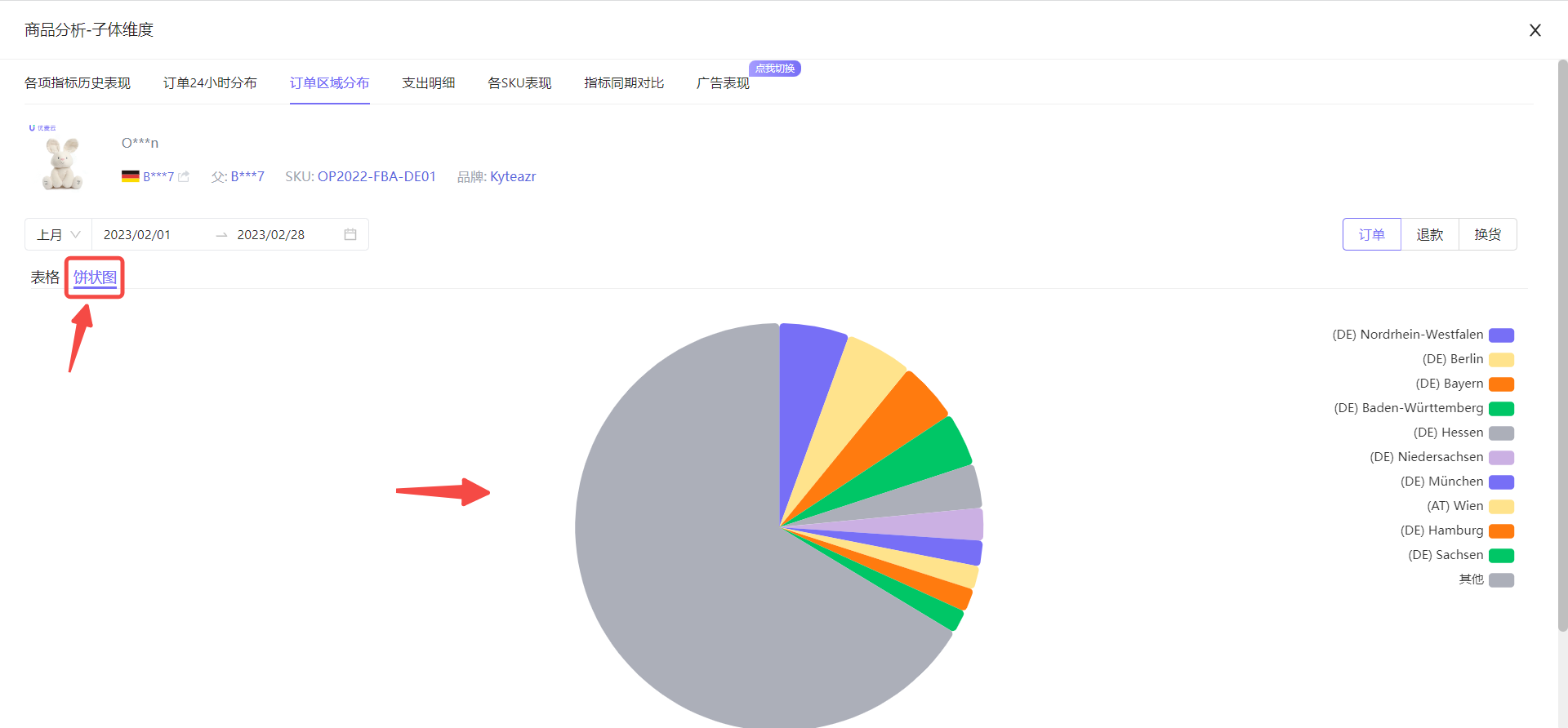 +
+
Hover the mouse over the corresponding pie slice to also view detailed data.
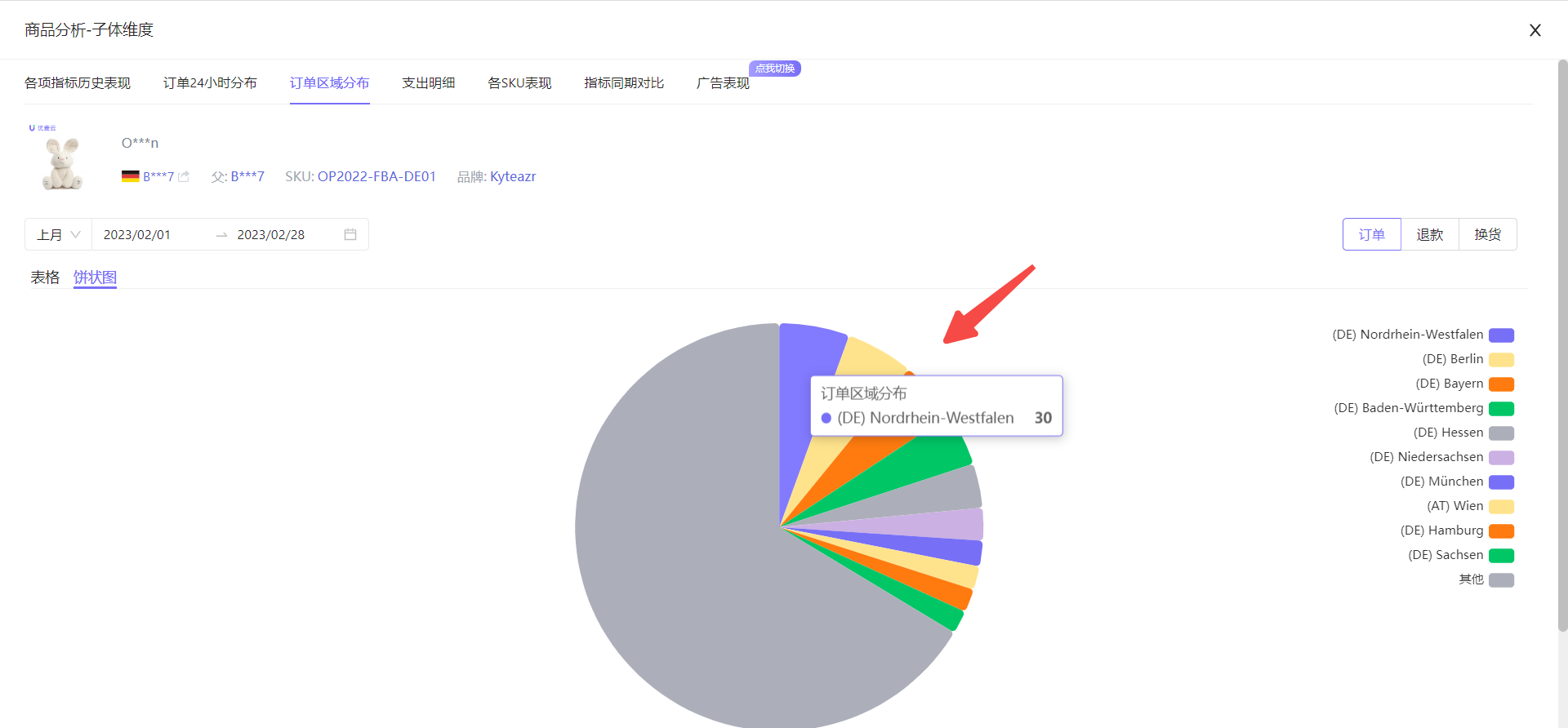 +
+
Click the chart block label on the right to display or hide the data separately.
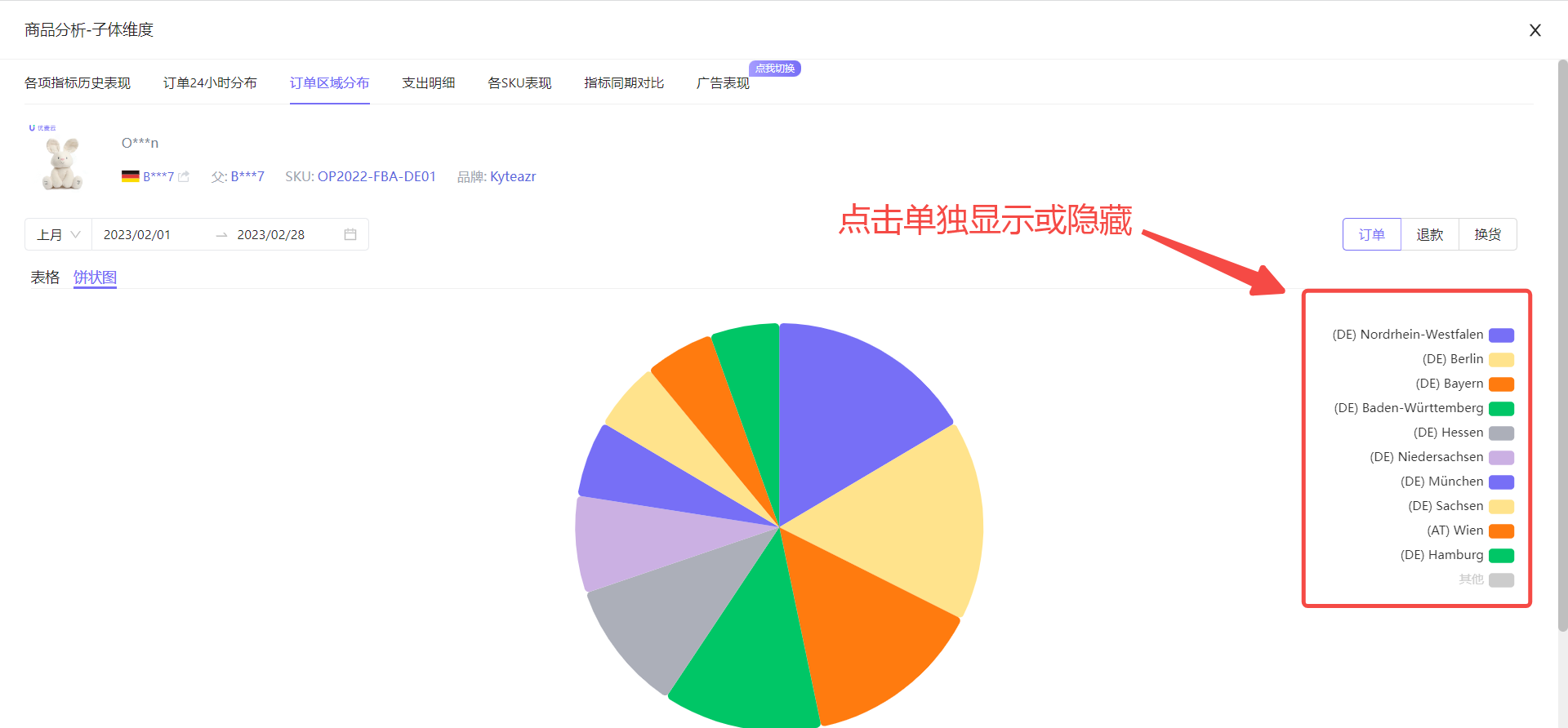 +
+
Through the above data, we can analyze and conclude that in the top ten ordering areas of this product, the area with the largest order quantity is (DE) Nordrhein-Westfalen, followed by (DE) Berlin.
If we use the keyword ranking or keyword positioning function, when capturing data, we can prioritize using the zip codes of these two areas to help us obtain more accurate orders.
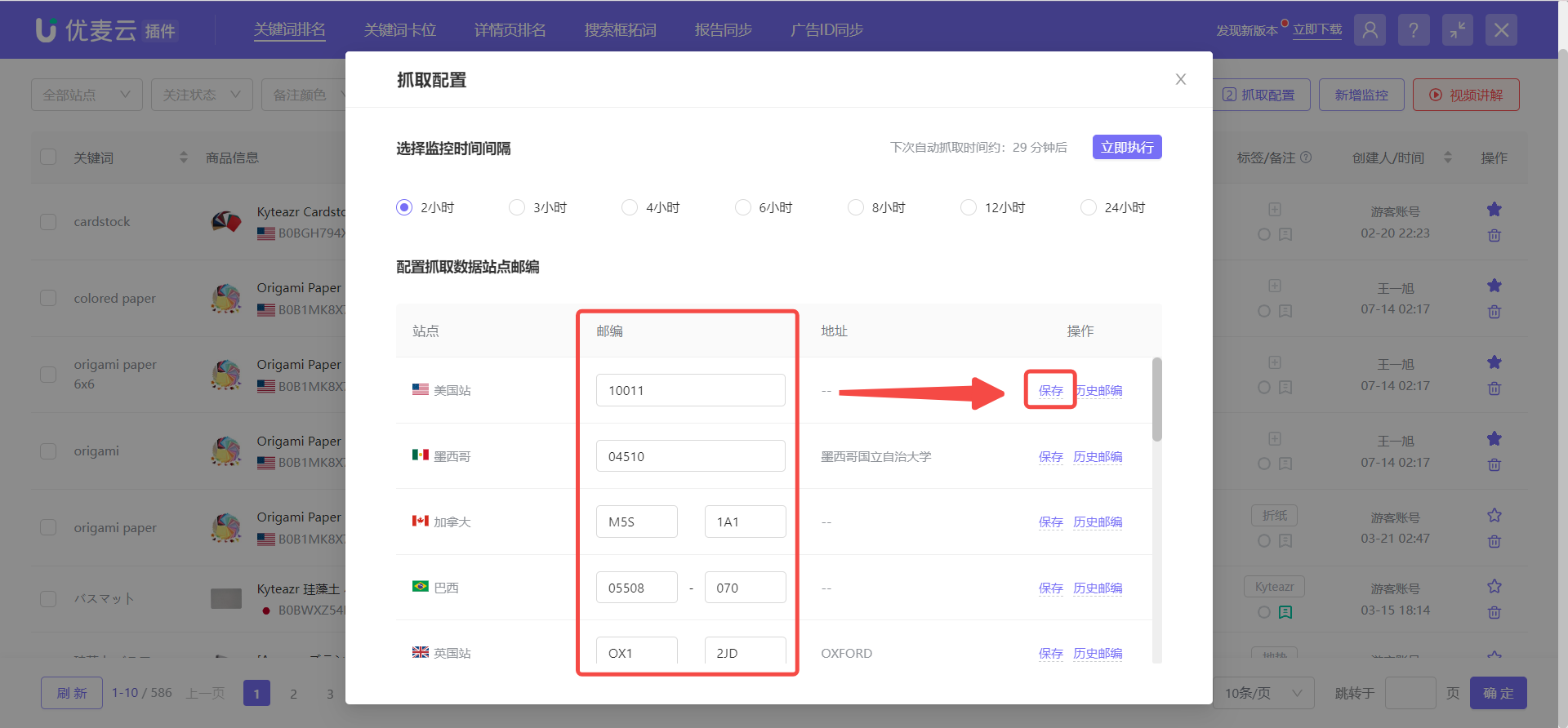 +
+
In addition to viewing the order distribution of all orders, you can also analyze the area distribution and reasons for returns and exchanges.
Return and Exchange Area and Reason Analysis:
The viewing and analysis operations of return and exchange area distribution are consistent with order area distribution.
Click the data button in the upper right corner to switch with one click.
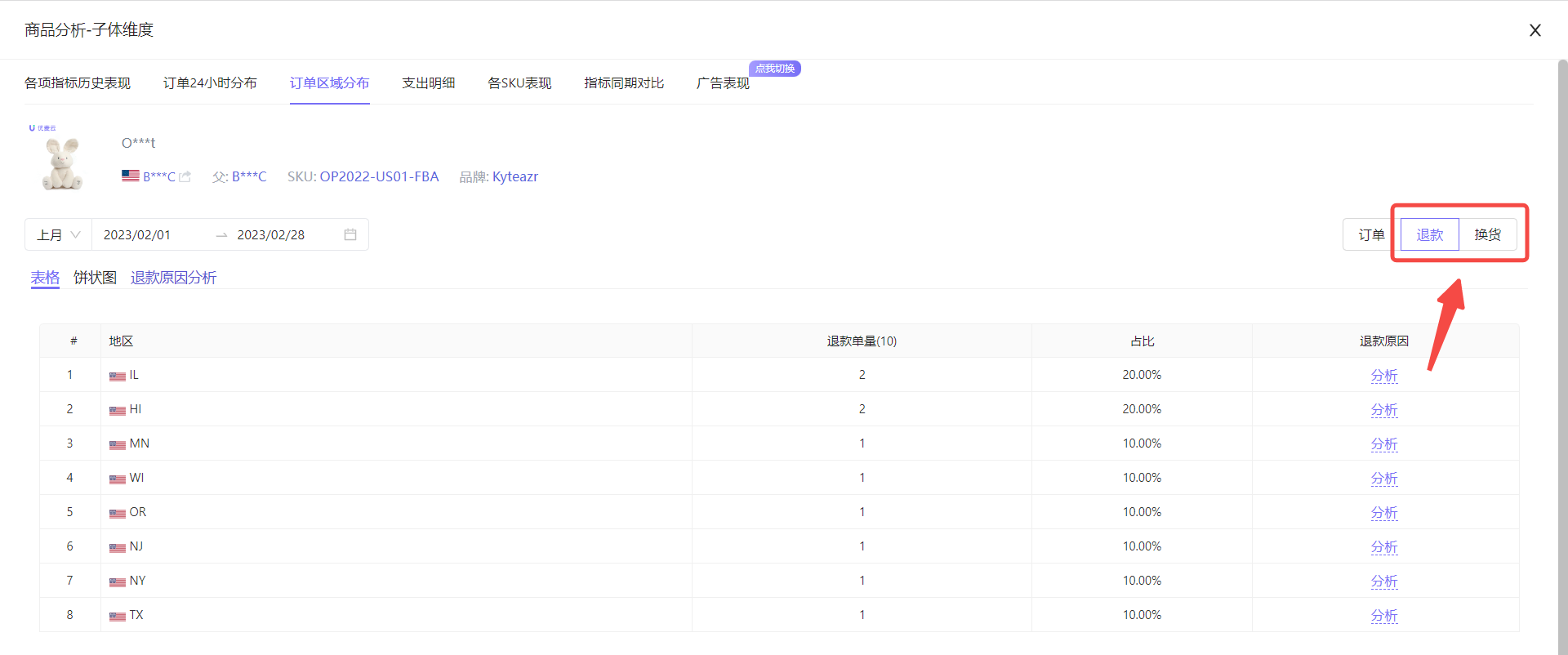 +
+
In addition to area distribution analysis, we can also directly analyze the reasons for returns and exchanges here, and the method is consistent.
Taking analyzing the reasons for returns of the selected product for last month as an example.
Click to enter the [Return] area distribution data and select [Refund Reason Analysis] to enter the data analysis page.
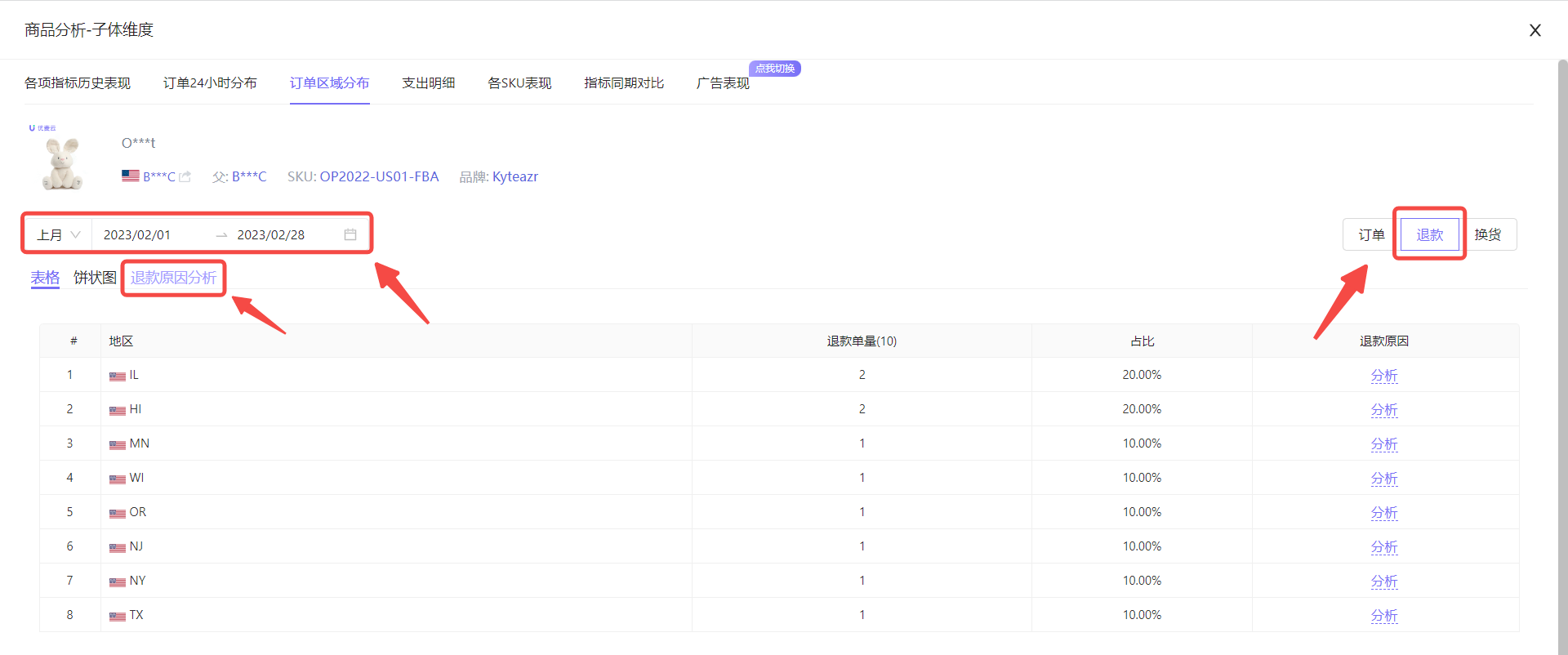 +
+
Entering the "Refund Reason Analysis" page,
we can see that among the reasons for returns of this product last month, "Ordered wrong item" accounted for 83.33%, which is the biggest reason for returns, while the remaining reason is "No longer needed/wanted", which indicates that the goods received by users are inconsistent with their expectations.
At this time, we can check whether our description is inconsistent with the goods, or whether the wrong goods were sent, and make corresponding adjustments to reduce subsequent economic losses (Amazon FBA's return and exchange shipping costs are borne by the seller).
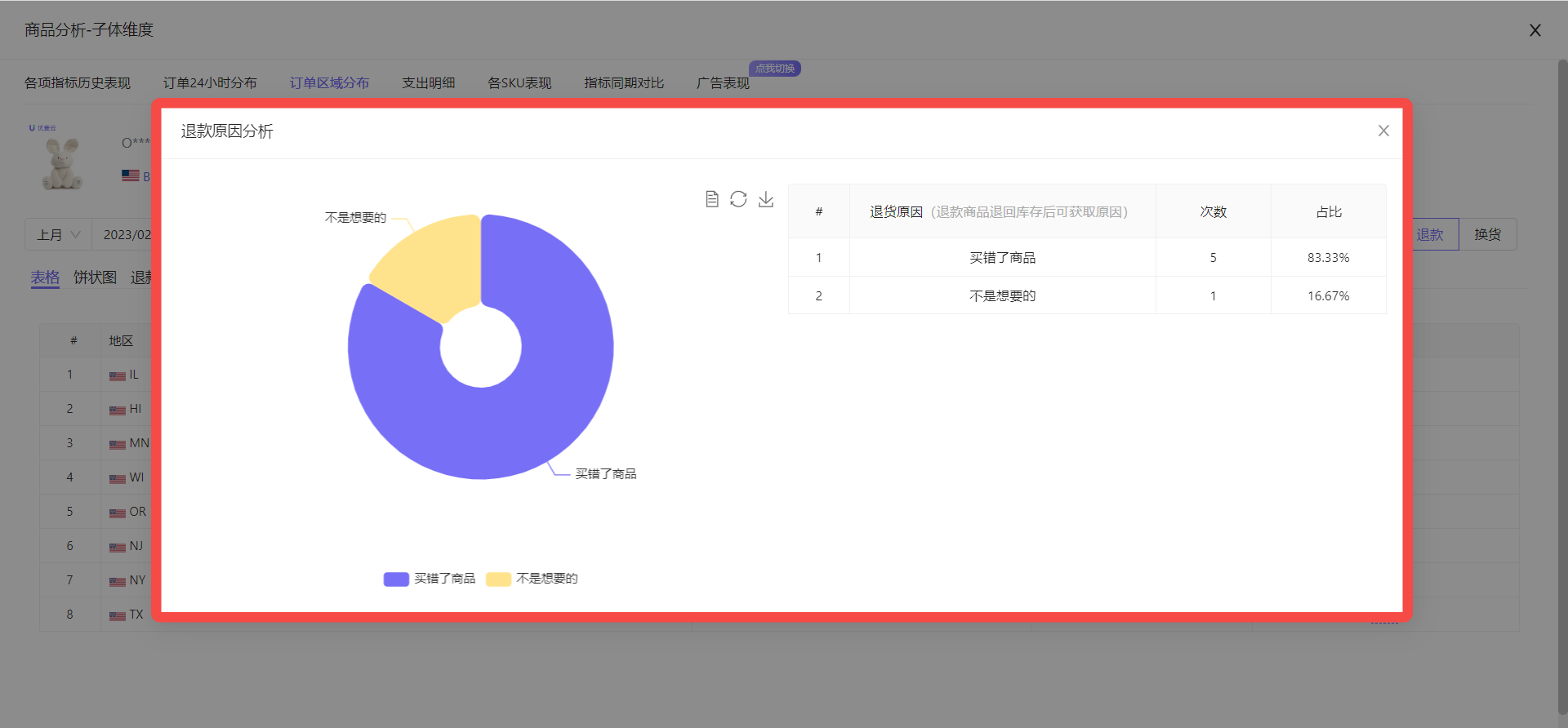 +
+
If there are many reasons for refunds, we can also click the chart block below to display or hide the data separately.
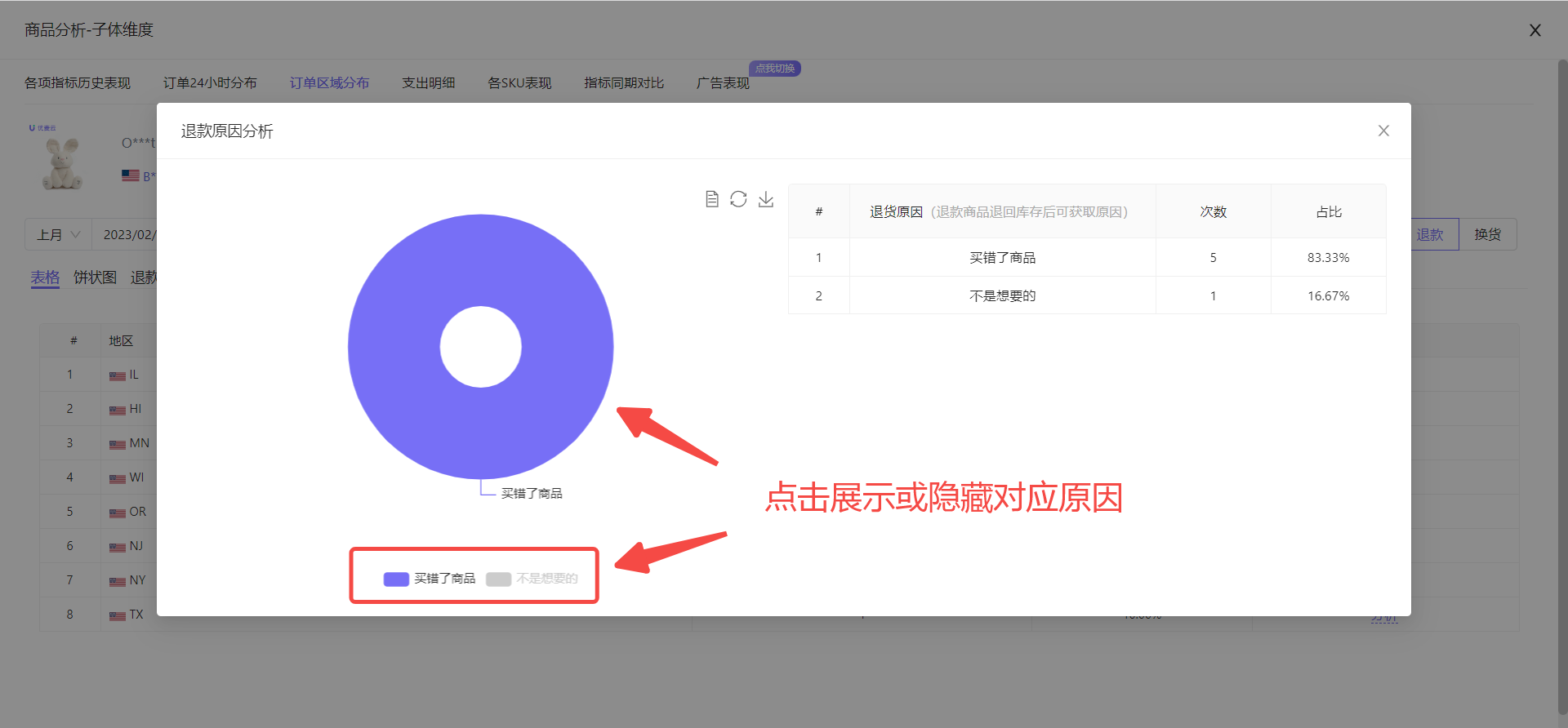 +
+
If there are many reasons for refunds, and there are many operations to display or hide separately, if you want to restore to the initial data display, you can click the restore button to restore with one click.
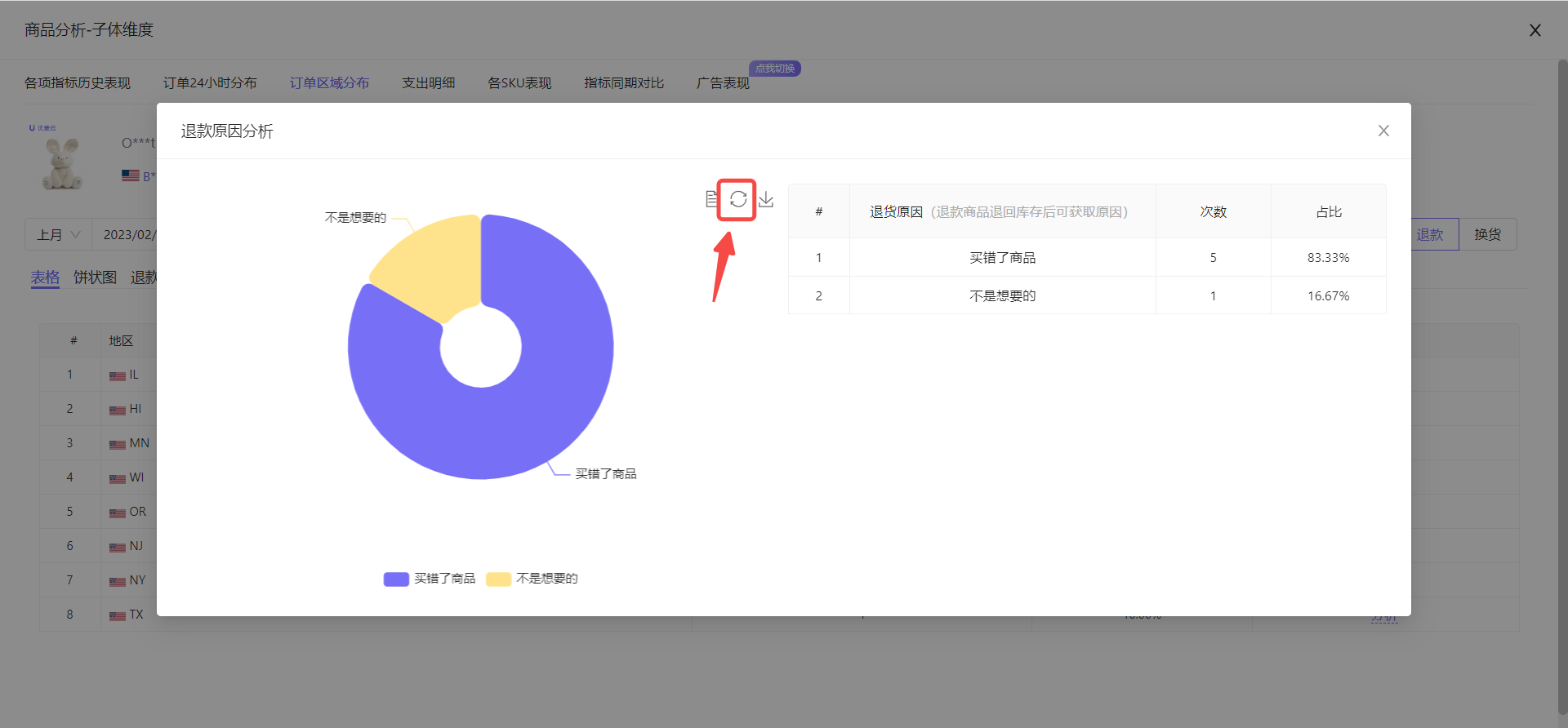 +
+
The current chart also supports exporting, exporting to image format, which is convenient for us to make reports.
Click the export button to export with one click.
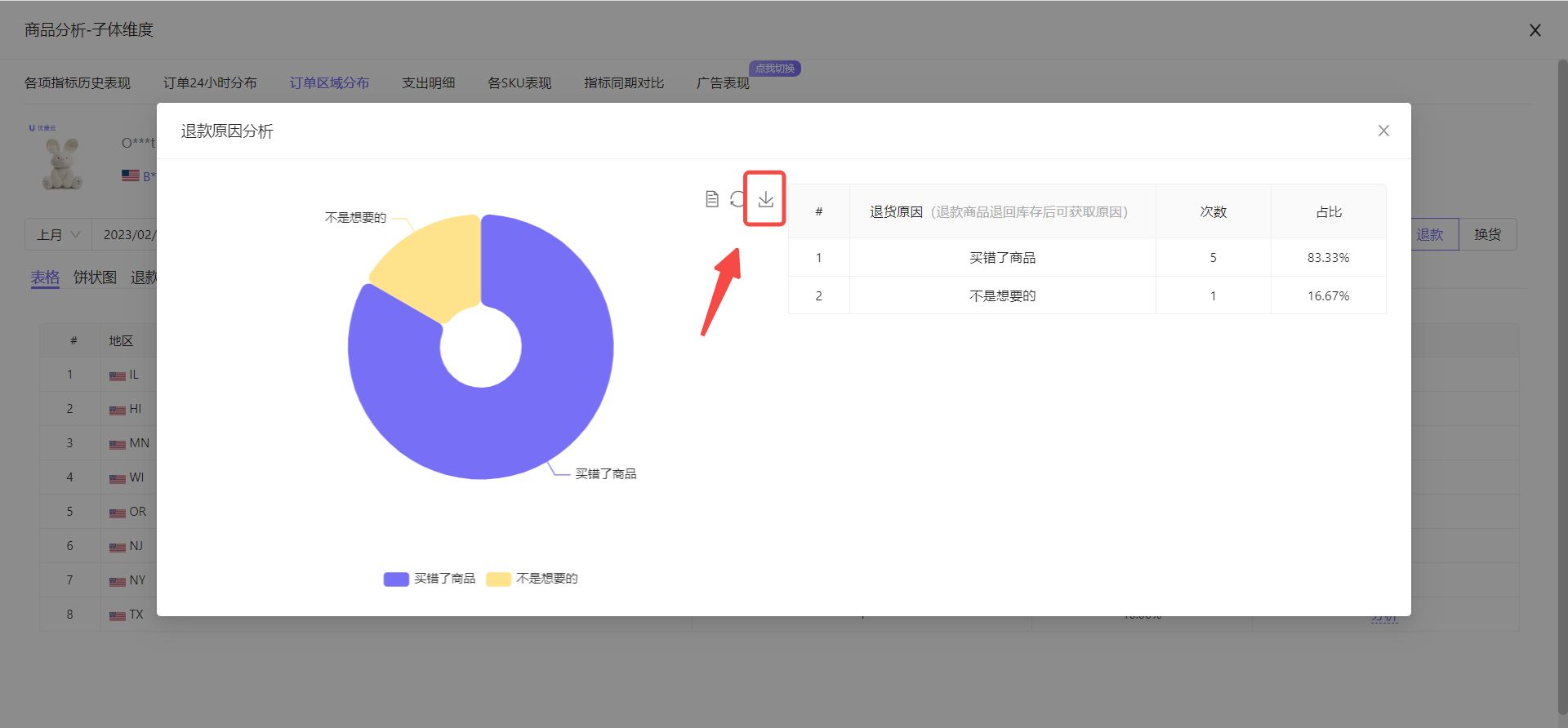 +
+
In addition to direct chart analysis, we can also switch to a pasteable and copyable table, copy the data out for archiving, or meet other copy and paste needs.
Click the chart button above to switch with one click.
 +
+
Directly copy and paste:
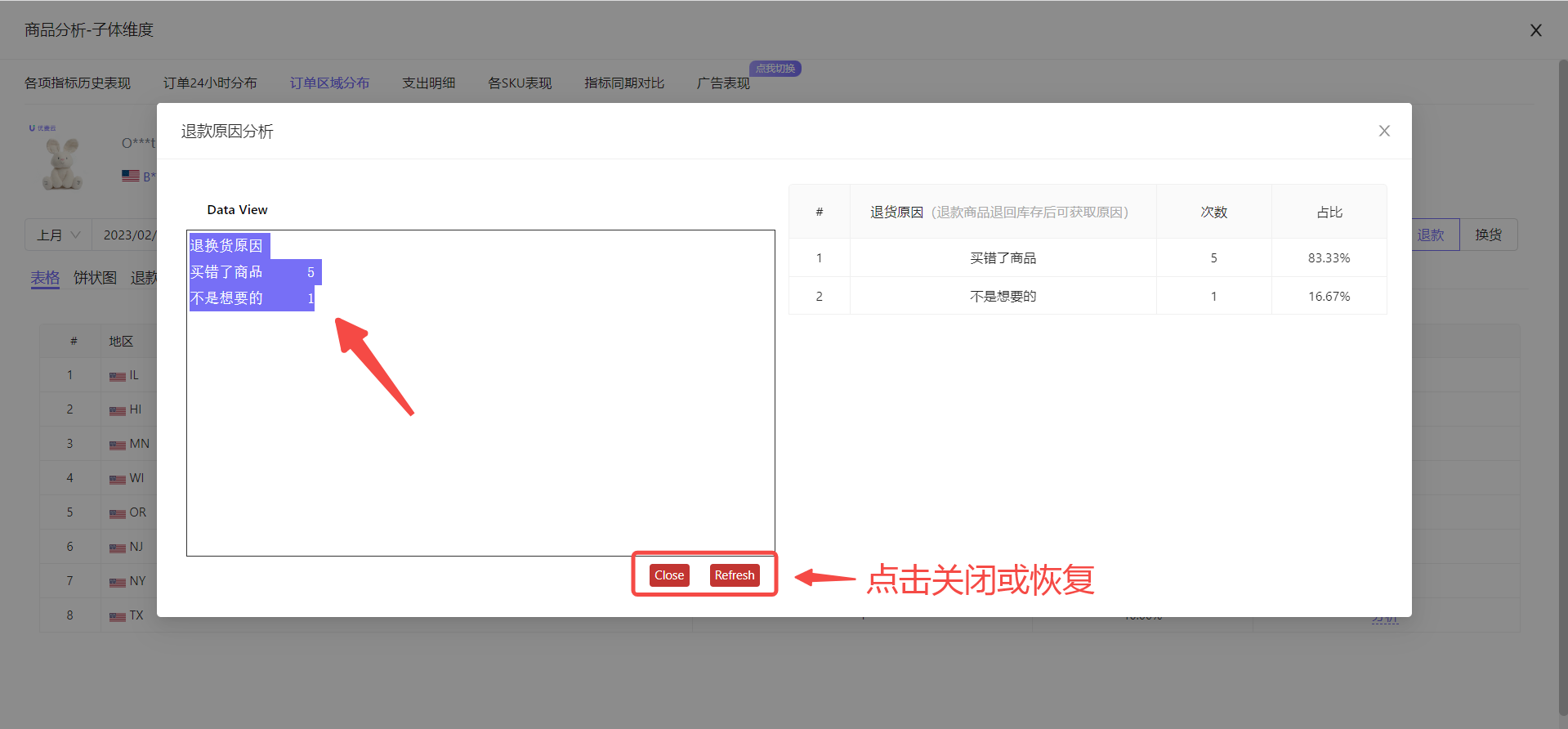 +
+
In addition to analyzing the reasons for returns and exchanges of the entire product, we can also separately analyze the reasons for returns and exchanges in the top ten areas in terms of returns.
Enter the refund/exchange area distribution data page, click the [Analysis] button on the right side of the area you want to analyze to enter the analysis page.
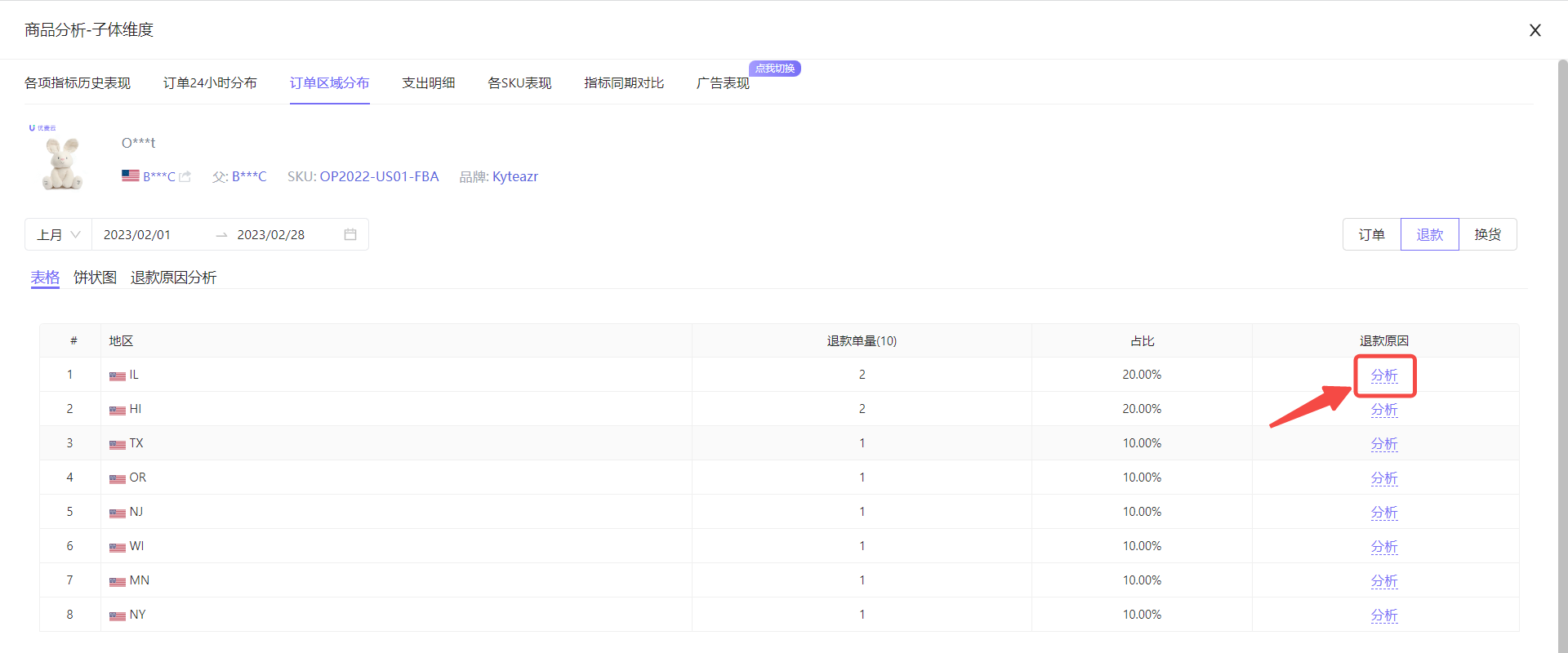 +
+
The analysis method is consistent with the reason analysis of returns and exchanges for the entire product.
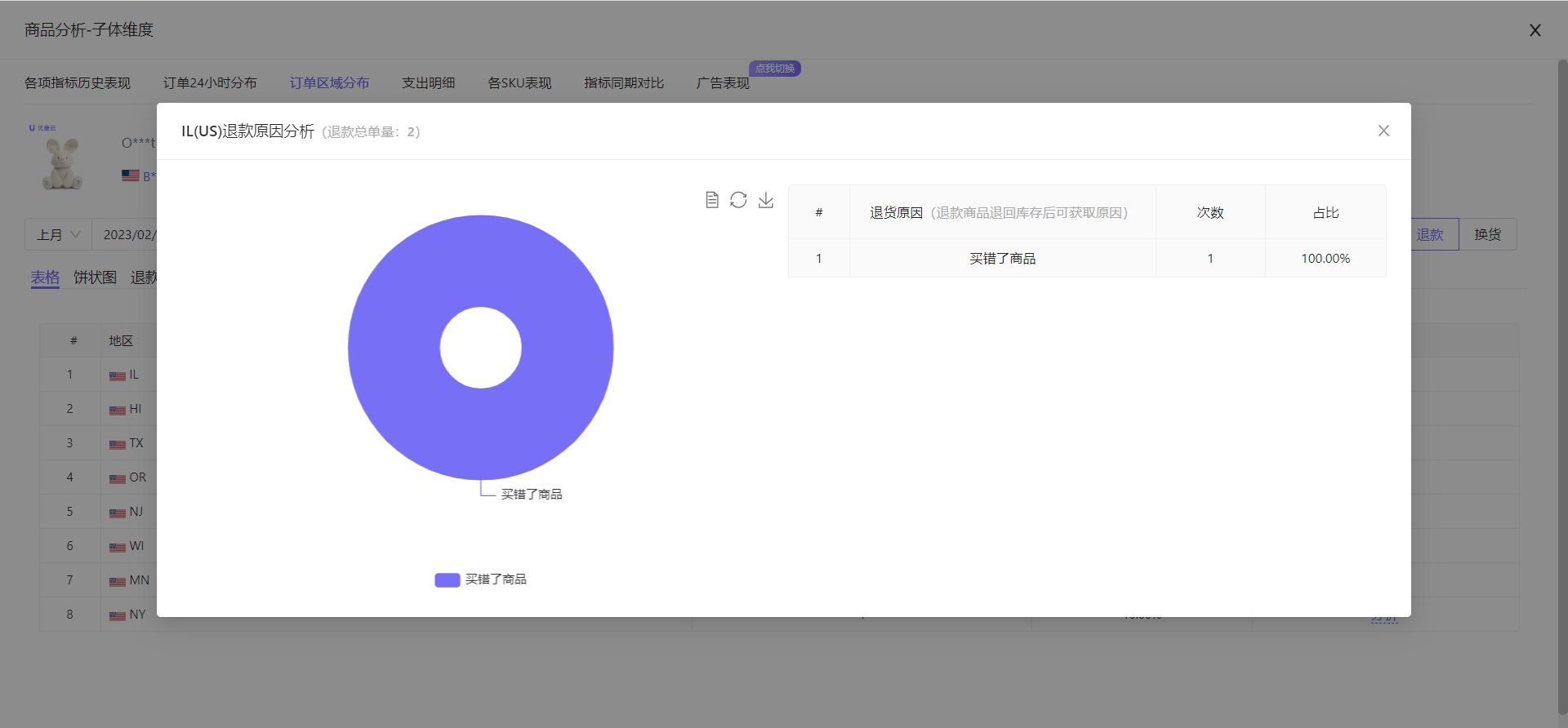 +
+
④ Expense Details
Expense details show the various types of total expenses of the current product and the data share of each type, helping us review operating expenses.
We can quickly find out the main expense focus, whether the target expense meets the standard, and whether there are anomalies in marketplace expenses by analyzing product expense details.
 +
+
Taking reviewing the expenses of the selected product for last month as an example,
First, select the data time: Last Month.
Similarly, we can customize the data time range of expense details.
However, it should be noted that due to some pending orders, Amazon may return 0 data within a certain period. At this time, we may adopt budgeting. Therefore, if the selected time range is recent, Amazon FBA fees, commissions, and other fees may be 0 or distorted. Therefore, it is recommended to choose a longer time span for analysis.
Click me to learn about SellerSpace order budget
Click Time in the upper left corner and select the data time range: Last Month.
 +
+
After the time and marketplace are set, the data below will automatically switch, including: Total Sales Revenue, Total Expenses, Total Profit, Expense Details, and Pie Chart of Each Expense Type.
 +
+
Among them, hovering the mouse over each color block can also view detailed data.
 +
+
At this time, we can directly view the expense details of the selected product for last month.
For example:
It can be seen from the above data that the overall profit of this marketplace is relatively low, and the advertising spend share and FBA fees are significantly higher.
We can speculate that the current product may mainly rely on advertising to generate orders, or there may be unreasonable advertising placement. Is it because traffic is mainly obtained through advertising, or is there a problem with our advertising strategy, thus consuming a lot of profit? Or is it that the pricing is unreasonable, resulting in our very thin profit? ... Specific analysis can be made based on the specific situation.
⑤ Performance of Each SKU
When the viewing dimension we select is: Child ASIN dimension or Parent ASIN dimension, the [Performance of Each SKU] data dimension will appear in Product Analysis.
Why is this?
Because SKU is the smallest unit of Amazon products. A parent product (Parent ASIN) is composed of multiple child products (Child ASIN); a child ASIN (Child ASIN) can generate multiple SKU products (same product, different SKUs, such as hijacking operations).
Therefore, if we have the above product sales situation, we can analyze the data to the smallest dimension.
 +
+
⑥ Period-over-Period Comparison of Metrics
Same as Marketplace Analysis, the period-over-period comparison of metrics in Product Analysis can help us analyze the changes in various sales metrics of the selected product, analyze whether the optimization operation is correct, and whether there are anomalies in daily operations, helping us quickly find loopholes and optimize in time.
 +
+
Taking analyzing the advertising order changes of the selected product for last month in curve graph form as an example,
Click the metric selection bar in the upper right corner and select the metric to be analyzed [Ad Orders],
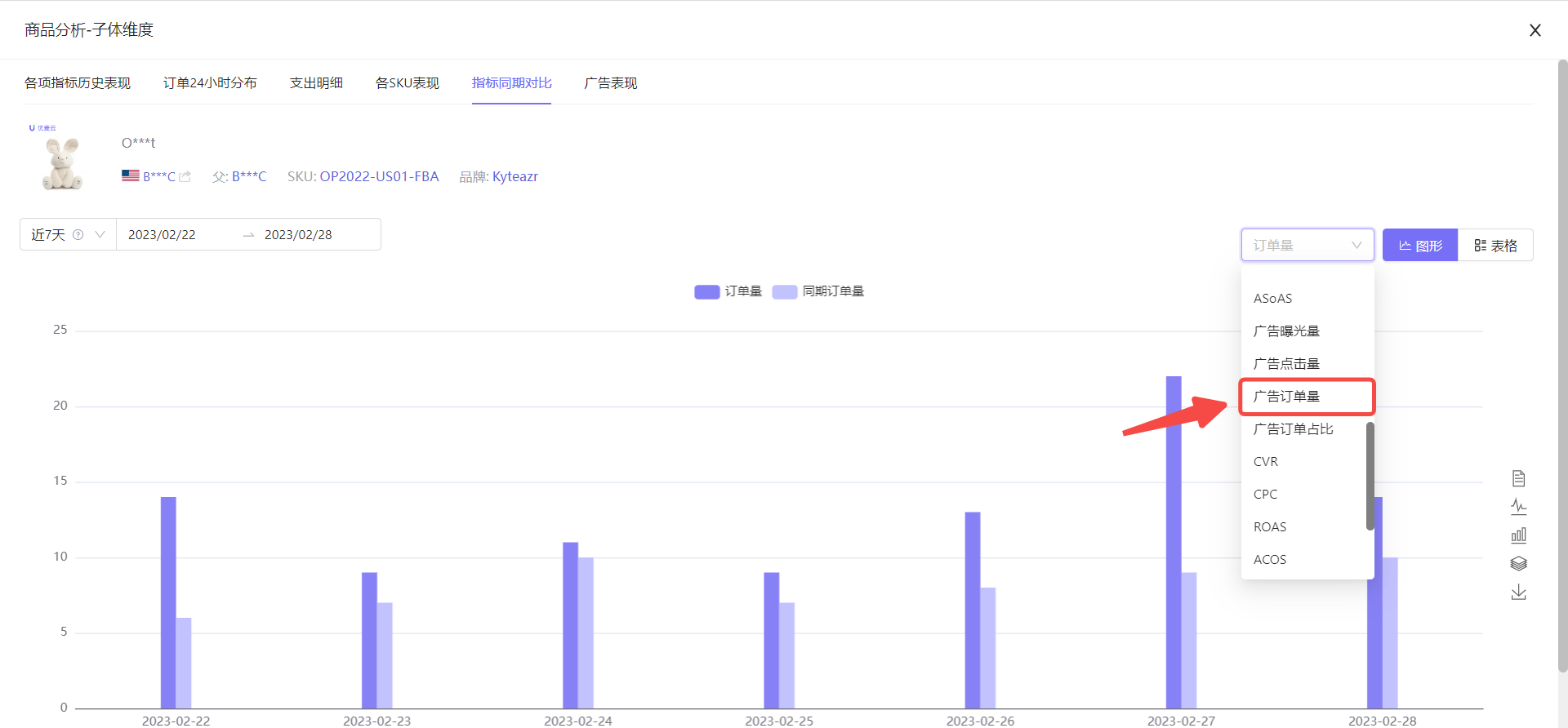 +
+
After selecting the metric, we continue to select the time and data presentation form to be analyzed.
The above operations are basically the same as [24-Hour Order Distribution].
We directly select time: Last Month, presentation form: curve graph.
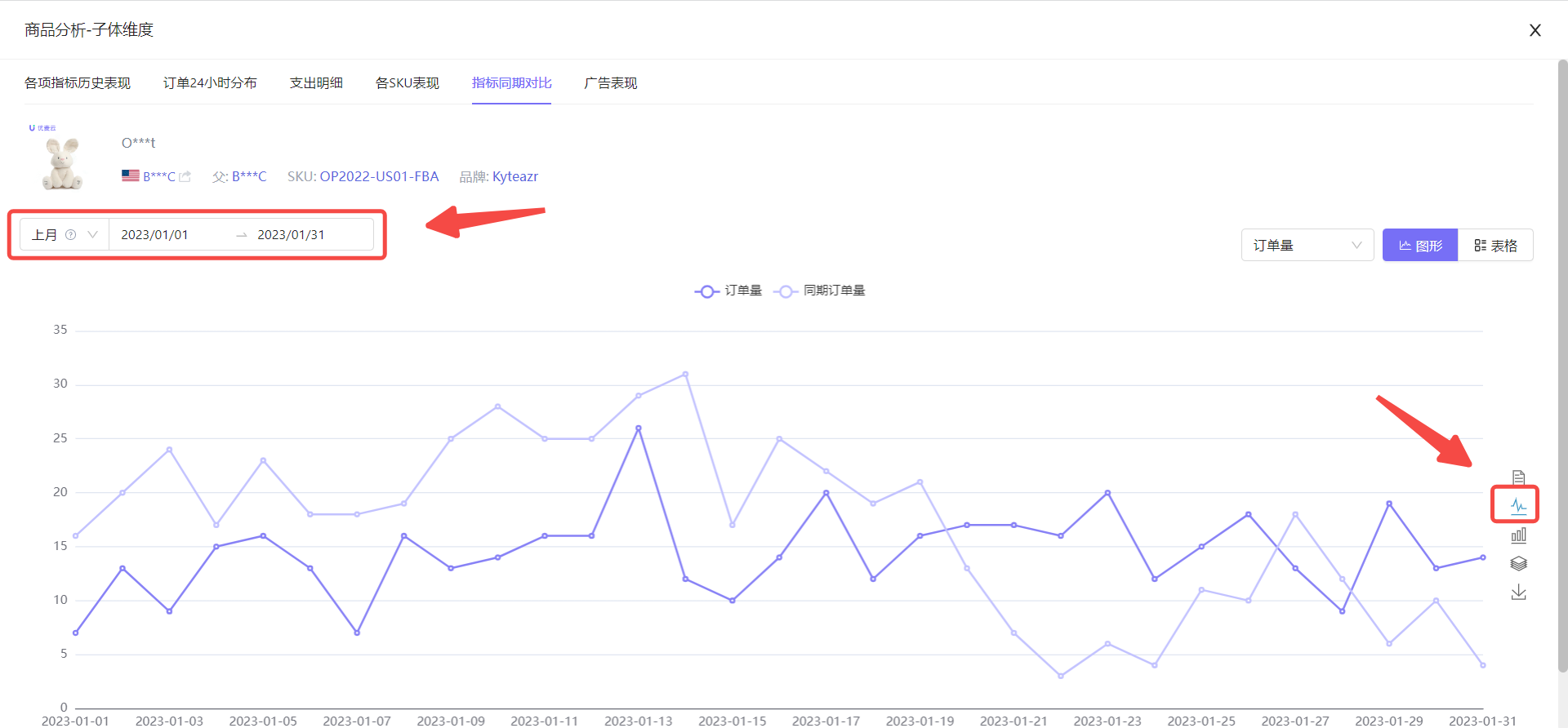 +
+
Through the above operations, we get the target data.
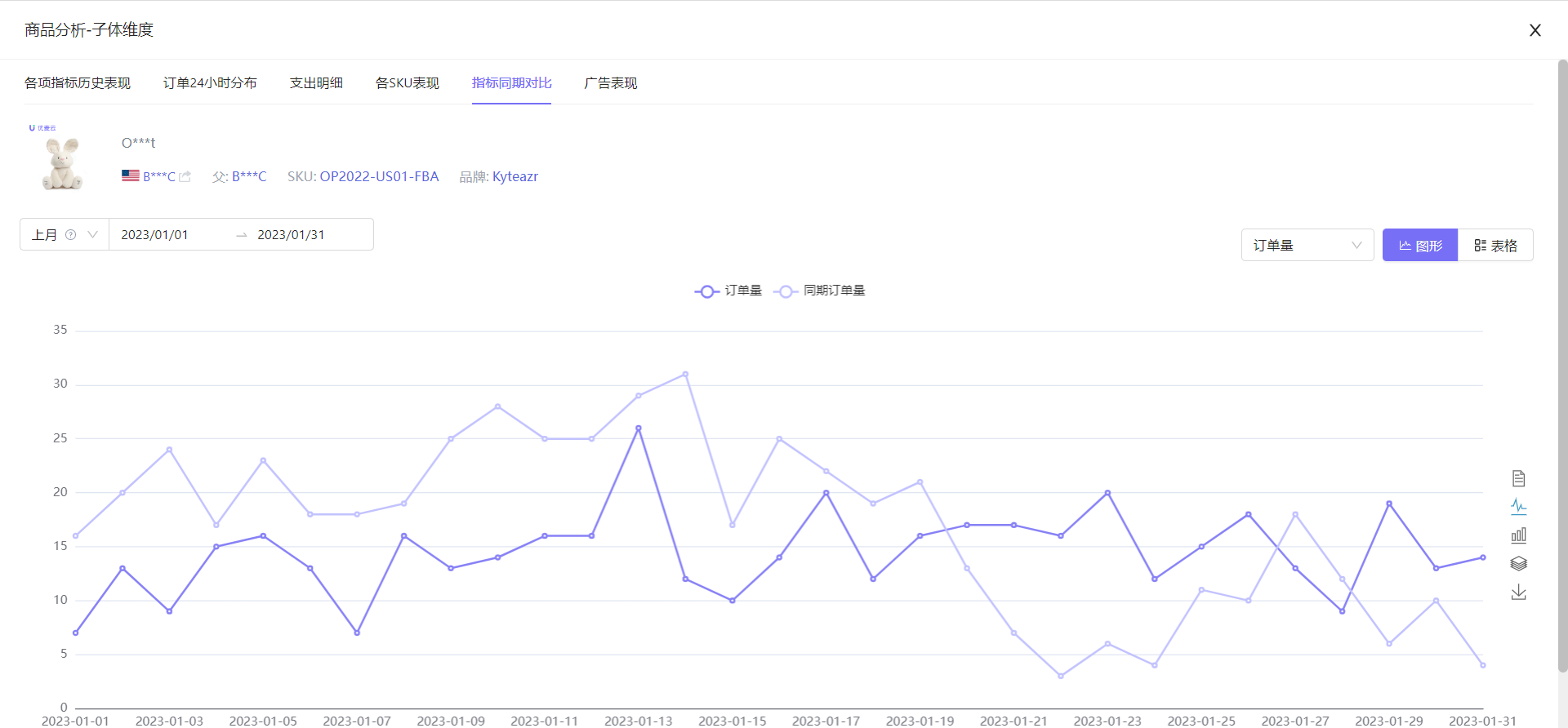 +
+
At this time, we can analyze through the curve chart.
For example, through the chart data, we found that from January 19, 2023 to January 27, 2023, for a continuous period of time, only this week, the order quantity of the selected product has always exceeded the previous month. What could be the reason?
At this time, we can speculate that it may be that we have made some optimization adjustments that have had an effect, but have not been maintained; or we participated in Lightning Deals, such as 7-day Lightning Deals, which happened to be that week, allowing sales to rise, etc.
We can make corresponding adjustments and optimizations based on different analysis results in the future.
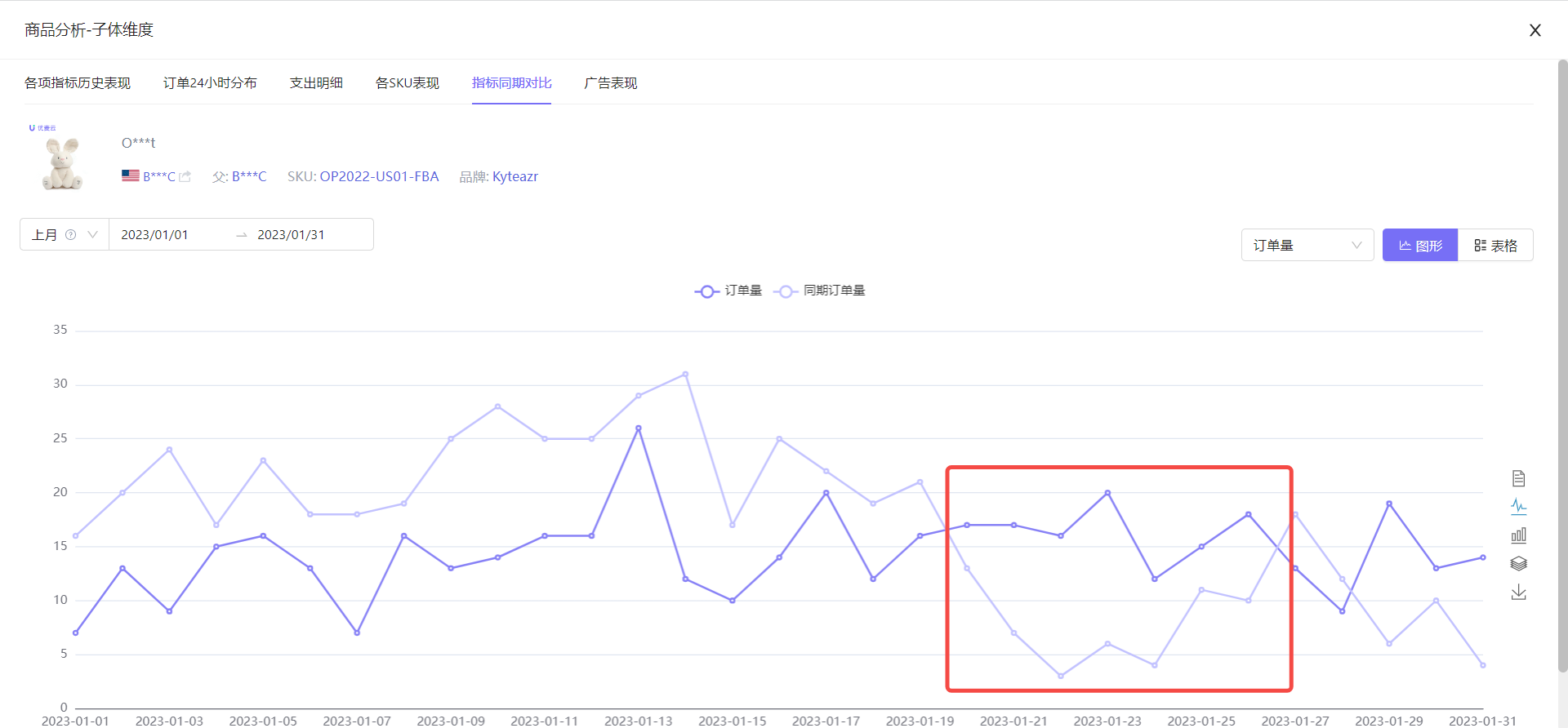 +
+
⑦ Advertising Performance
The advertising performance data of Product Analysis shows the campaign performance data of promoted products under the selected product and time. We can directly view and analyze the advertising performance of the product here, which is convenient and quick.
All analysis operation methods here are consistent with "Advertising Management -> Promoted Products".
Click me to learn about "Promoted Products - Help Guide"
One point to add here: The advertising performance of promoted products does not include Sponsored Brands (SB) ads.
Why not include Sponsored Brands (SB) ads?
Because what is displayed here is promoted product advertising, which is product-dimension advertising performance, while brand advertising is brand-dimension, that is, marketplace-dimension advertising performance. The dimensions are different, and brand advertising data cannot be allocated to a single product, so it is not included.
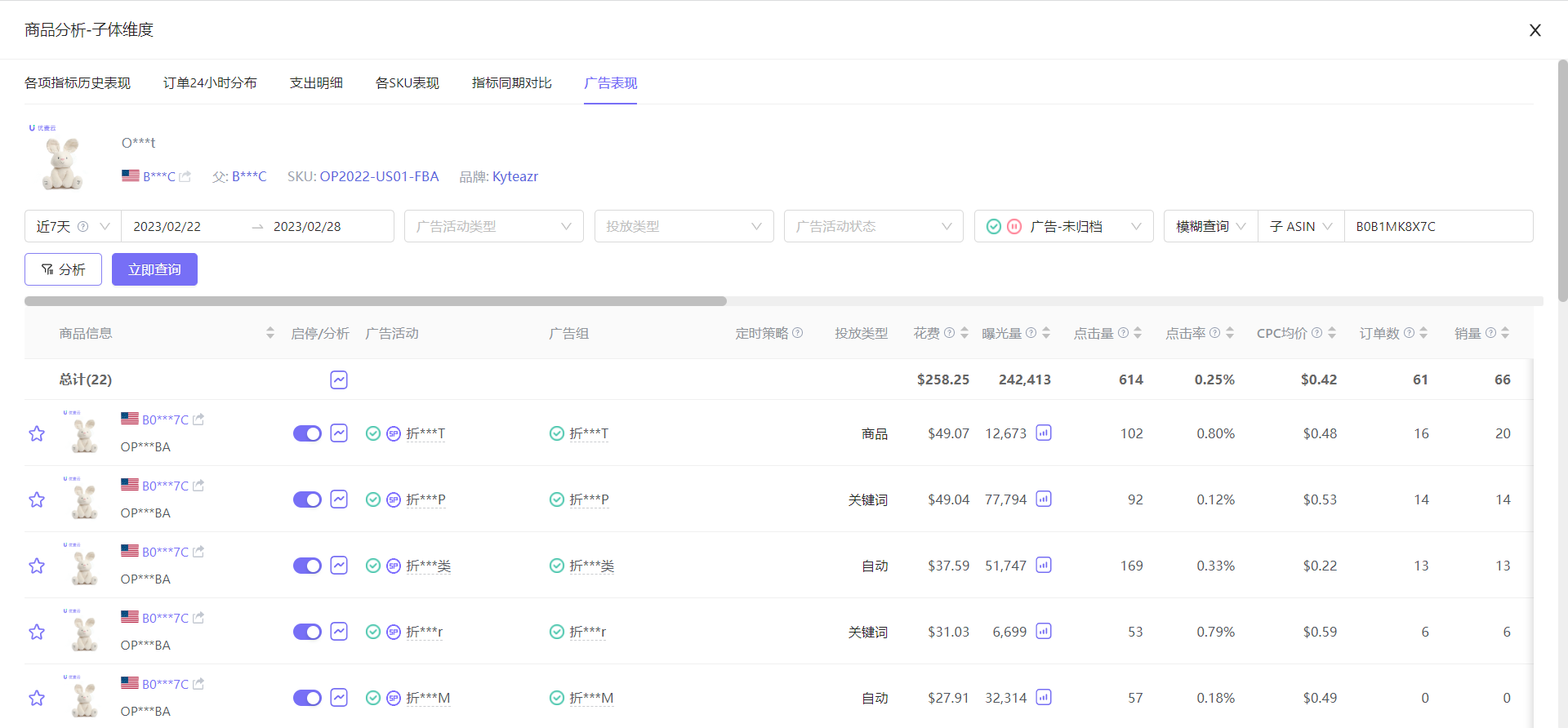 +
+
3.8 Product Analysis: Quick Jump
After we analyze the product, if we want to further view other information of the product, such as inventory status, whether it is being hijacked, and product cost, we can directly click jump here in the order product distribution, which is very convenient.
Inventory: Jump to the [Inventory Analysis] function to help us further analyze the inventory status, such as: how many days of stock are left? Do you need to replenish stock? ...
Monitoring: Jump to the [Hijacking Monitor] function to help us further analyze the hijacking situation, such as: whether there is hijacking, hijacking details, etc.
Cost: Jump to the [Product Cost] function to help us further view the cost changes of the product.
Click the jump button and select the corresponding data to directly jump to the corresponding function page.
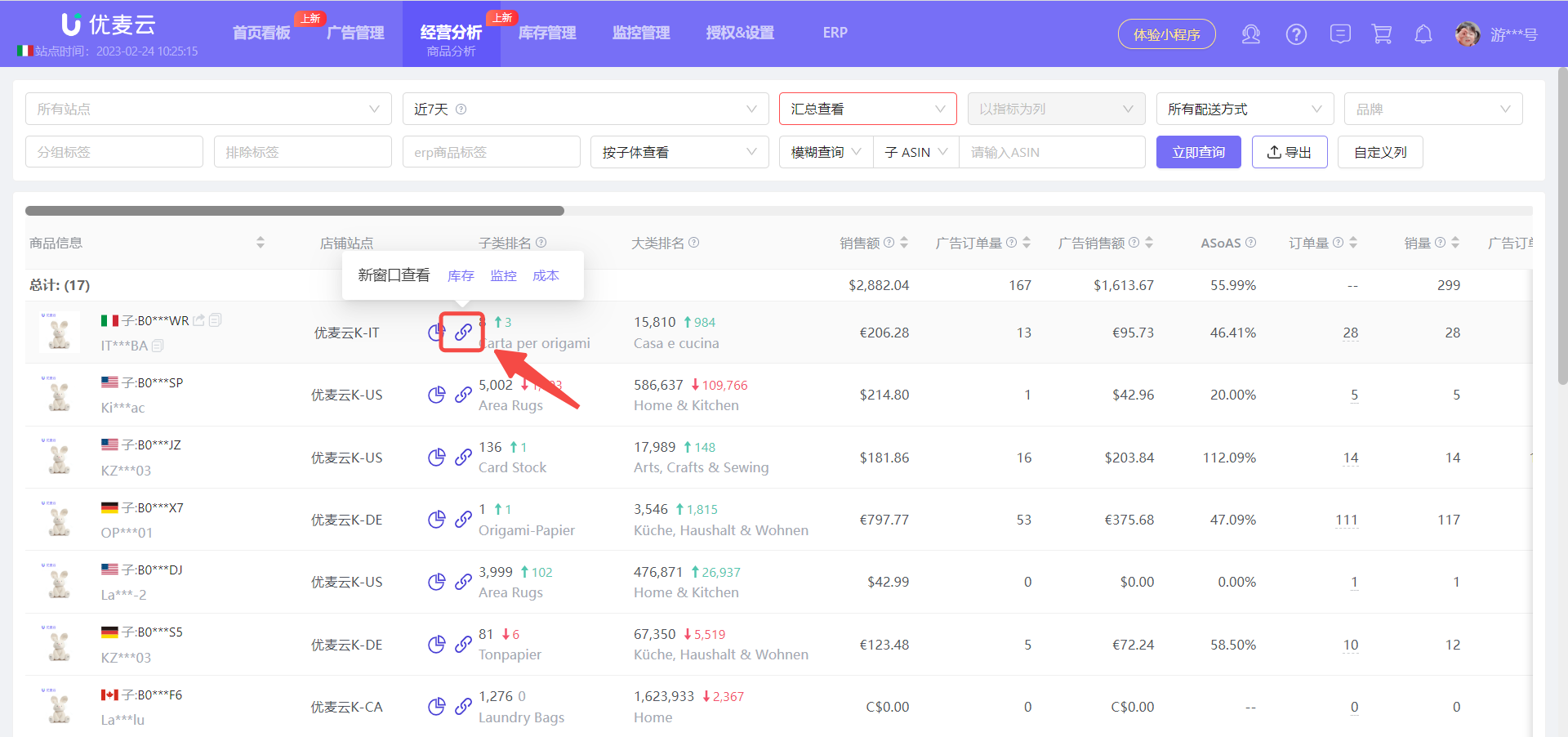 +
+





